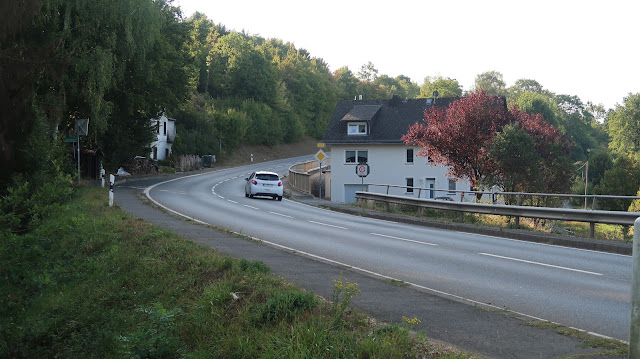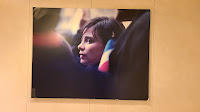An image of the old farm just off the highway immediately popped into my mind as my wife and I turned sharply into the triangular courtyard at the bottom of the hill. The Bauernhof looked astonishingly familiar. The house was nestled between the highway and a small farmer’s access road that ran along the river. I drove past it every day for three years on my way to and from work in the early 1960's.
The farmhouse was just over a small bridge over the minuscule River Nims, which in North Carolina would probably be called a creek, but this is the Eifel region of Germany, and the small, innocuous river played havoc with the area just two years earlier with horrendous flooding. Luckily, our hosts for the next three weeks, Ludwig and Walburga Pax, were spared any damage.
They were kind enough to let us stay with them as they had an empty apartment on the ground floor of the old, but completely refurbished farmhouse. The arrangements were made by other German friends of ours so we could spend time in Bitburg, Germany, my wife’s hometown. Bitburg Air Base was also home to the 36th Tactical Fighter Wing and the 71st Tactical Missile Squadron, my duty station for over five years during two separate assignments. Bitburg was made famous in May, 1985, by President Reagan's visit to a local cemetery that drew both praise and condemnation.
Our hosts were very cordial as my wife and I spent the first several days going and coming, shopping in town, sightseeing and catching up on old friendships. We also got to meet several people we had friended on-line, mainly through Facebook. Soon, Ludwig and Walburga invited us to join them in their garden patio for a glass of wine and we immediately accepted. They had just returned from Tirol in Northern Italy where they celebrated their Silver Wedding anniversary. They had arrived home the night before we got there. They were settling in as much as we were.
Even with my rusty German, bolstered by my wife’s translation skills, we were soon reminiscing about the old days when blue US Air Force trucks roared up the hill on their way to Bitburg Air Base, or further on to Idenheim, one of our two launch sites. The missile support area where I worked was several miles back up the highway in the other direction. The Pax farmhouse was directly adjacent to the two-lane highway that connected the areas. The traffic on the highway back then was sparse, usually local farmers headed toward Oberweis or the farming villages scattered in the area. Occasional Luxemburgers came across from nearby Vianden, but the parade of blue USAF trucks and transporters and the colorful big, American cars of the officers and sergeants who worked at MSA or the other launch site we had at nearby Rittersdorf were just as common as the black-on-white license plates of the local residents. In the several days we had been there, it was obvious things have changed.
The traffic was incessant up and down the hill. Trucks of all shapes and sizes from Belgium, Luxembourg, Germany and even France were common, and the license plates of the continual flow of cars and SUVs reflected the economic state of the European Union, which seems to be doing quite well. The traffic at night slacked off little but the Pax’s newly rebuilt apartment had soundproof windows and window shades that insulated us completely from the outside world. While we were chatting about the differences between now and then, Ludwig laughed and told me about the day an Air Force truck brought him a donkey.
I sat up. Again, old memories began to stir.
Sometime during the late 1950's, while the TM-61C Matador was the primary weapon system of the 585th Tactical Missile Group, MSA was developed as the off-base maintenance area and the nearby Site VII was then known as "B" pad. Ludwig’s parents rented the apartment on the ground floor of the farm house to an American missileman who often brought candy or gum for Ludwig. One afternoon the renter was talking with Ludwig's father and asked Ludwig, who was six or seven at the time, if he wanted a bunny, a chicken, or a donkey. Young Ludwig said he’d rather have a donkey.
Several days later, a blue Air Force truck pulled into the farmyard towing a trailer. Several airmen opened the trailer and unloaded a donkey, complete with a box of feed and blankets. The American had asked Ludwig's father to house-keep the donkey for the Air Force, but Ludwig had no idea of how or why. Ludwig said he was very happy to get the Donkey.
I sat and listened to his story, my mind furiously spinning. I remembered posting a photograph on my web site of a donkey that had been brought back from Libya as a squadron mascot. It was taken from a squadron newspaper clipping in the late fifties and I suddenly remembered where to find it. I went inside and logged on to Ludwig’s W-lan – it’s not called WiFi in Germany – and pulled up the photo of the donkey. When I showed it to Ludwig, he was speechless. He went inside and came back out with a photo of him sitting on the donkey! Now I was speechless.
 |
| Ludwig Pax, about 5 or 6 years old, with his mother Photo courtesy of Ludwig Pax |
A Martin Company civilian named Bill Baily accompanied the 71st Tactical Missile Squadron to Wheelus Air Base in Libya as a Technical Representative during a live-fire exercise done annually by all of the tactical missile squadrons assigned to NATO. The exercises, called AMLO, or Annual Missile Launch Operation, were done from 1954 through early 1959, with thirty-six Matador missiles launched annually at an area sixteen miles from the Wheelus flight line. While on the 1959 exercise, Bailey somehow acquired a burro from a Libyan local near the launch area outside of Tripoli and managed not only to get it on the C-119 flight back to Bitburg, but also got the Squadron to adopt the animal as its mascot. Renamed to Mahl Ish from whatever it was called before, the new name supposedly reflected the phrase “mox nix,” the military bastardization of the German phrase “machts nicht,” roughly translated as “doesn’t matter.” Someone even had a blanket made, probably in Libya, with the burro’s new name across the top and the squadron insignia proudly emblazoned in the center. It would be hard to imagine the 585th Tactical Missile Group commander, Col Fred Vetter, wasn’t in on the stunt as 1st Lt. Sherman J. Uchill was assigned as Mahl Ish’s custodian.
Ludwig did not remember the name of the American family his father rented to, but he remembered when the Air Police – since renamed to Security Police – knocked on the farm house door one afternoon asking to speak with the American renter. The tenant produced documents about the burro that satisfied the police and they left, leaving the burro with the Pax family.
Ludwig remembered having the burro for several years, with the Air Force coming by every once in a while to pick up the animal for special events, but they always brought the animal back to the farm. He also remembered the burro getting out of his pen more than once, one time going all the way to the main street in Bitburg before Ludwig's father found him.
Ludwig doesn't know the fate of the burro, only that one time the Air Force picked up the burro and that was the last time he saw it.
 |
| Not only does Ludwig still have the shears used on the burro... |
 |
| ...he also still has the original box it came in! Both photos courtesy of Ludwig Pax |
Determined to fill in the blanks after we were back home, I asked Russ Reston, webmaster for the TAC Missileers Association if he could put a blurb on their site asking anyone for information about the mysterious squadron mascot. He put my odd request on the Web page and the next morning I had an answer from Mike Fedrick, a missileer who served with the 585th TMG from 1959 until 1962, the year I arrived in the group.
Mike wrote “I was in the 71st TMS from 1959 to 1962. The donkey was brought to Germany from Libya in 1959 by the last group to go to Libya for combat ready launches. The rest of us went to Cape Canaveral for launches.
“I got to know the donkey up close and personal. When the 585th Tac Missile Group had a summer picnic for dependent children, the group commander (Col. Vetter) had me pick it up from the German farmer that was taking care of it, load it into a weapons carrier, take it to the picnic, and lead it around with kids riding on it, load it back, and take it back to the German farmer. My memories of this event are unpleasant because the donkey did not want to get into the weapons carrier, both when I picked it up and when we had to load it to take it back. The German farmer got it loaded the first time, but it took several of us to load it to take it back.
“I was told I was chosen for this onerous task because I’m from Texas. I’m actually good with horses, but never had to deal with a donkey before or after. As you know, Mox Nix means "makes no difference".
“Best regards, Mike”
I have no idea what strange stories will pop up next time we visit Bitburg, but it will be hard to top meeting Ludwig and hearing about his donkey.
George
 |
| Ilse Mindling, Walburga Pax, Ludwig Pax, George Mindling Steinebrücke, Bitburg, Germany, September 2022 |

















































